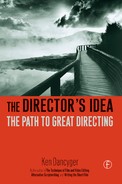Part I: What the Director Does
Chapter 2 • The Director’s Idea
Chapter 3 • The Competent Director
Case Study I. The Competent Director: Antoine Fuqua (“King Arthur,” 2004)
Case Study II. The Competent Director: Simon Wincer (“The Lighthorseman,” 1087)
A Case Study in Good Directing: Michael Mann’s “Collateral”
Chapter 5 • The Great Director
Three Contemporary Great Directors in America
Three Contemporary Great Directors Outside America
Chapter 6 • Text Interpretation
The Case of Steinbeck’s East of Eden
Political/Sociological/Psychological
An Aside about Actors as Directors
Part II: The Case Studies of Directing
Chapter 9 • Sergei Eisenstein: The Historical Dialectic
Chapter 10 • John Ford: Poetry and Heroism
“My Darling Clementine” (1946)
Chapter 11 • George Stevens: The American Character—Desire and Conscience
Chapter 12 • Billy Wilder: Existence at Stake
Chapter 13 • Ernst Lubitsch: The Life Force of Romance
“The Shop Around the Corner” (1940)
Chapter 14 • Elia Kazan: Drama as Life
Chapter 15 • François Truffaut: Celebrate the Child
Chapter 16 • Roman Polanski: The Aloneness of Existence
Chapter 17 • Stanley Kubrick: The Darkness of Modern Life
“2001: A Space Odyssey” (1968)
Chapter 18 • Steven Spielberg: Childhood Forever
“Raiders of the Lost Ark” (1981)
Chapter 19 • Margarethe Von Trotta: Historical Life and Personal Life Intersect
“The Lost Honor of Katharina Blum” (1975)
“The Second Awakening of Christa Klages” (1977)
Chapter 20 • Lukas Moodysson: Empathy and Its Limits
Chapter 21 • Catherine Breillat: The Warfare of Sexuality
Chapter 22 • Mary Harron: Celebrity and Banality
Appendix • Finding the Director’s Idea
